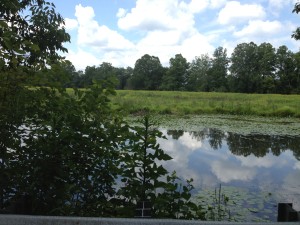Work is underway on a model ordinance to accommodate state mandates
By Kathleen Brady Shea, Managing Editor, The Times

Stormwater regulations aim to reduce the impact of flooding from county waterways such as the Brandywine Creek, shown along Creek Road in Birmingham Township.
County officials are fully immersed in a quagmire of water-runoff regulations, aiming to streamline a plan to handle new state changes in stormwater management, the commissioners announced last week.
The details – inarguably stultifying and dry – provide stark contrast to the aquatic subject matter as well as the project’s importance, especially for residents in flood-prone or under-developed areas, county spokeswoman Becky Brain said during a recent information session.
The county is navigating a phalanx of sometimes-competing federal, state and local regulations to create a municipal stormwater management model ordinance that will satisfy the state Department of Environmental Protection (DEP) while minimizing the adverse impacts, Brain said.
The ordinance is expected to affect a wide range of activities from agricultural operations to family patio installations to subdivision construction. Officials said stormwater issues seldom spark much attention from the public until a neighborhood ends up under water because too many impervious surfaces prevented rainfall from getting into the ground.
Janet L. Bowers, who heads the Chester County Water Resources Authority, said Pennsylvania’s Stormwater Management Act, known as Act 167, was instituted in 1978. It required watershed-based, stormwater management plans and municipal ordinances that regulated development consistent with those plans.
She said the state planned to reimburse counties and municipalities for 75 percent of costs related to its implementation, but the money never materialized, which put many proposals on a back burner.
Bowers said the county knew a day of reckoning would come and has been working for years on stormwater management. One of the challenges is developing an ordinance flexible enough to satisfy the diversity that springs from 73 municipalities and 21 watersheds, defined as land that drains into a common water source, such as the Brandywine or French Creek . For example, the needs of Tredyffrin Township vary dramatically from those of Lower Oxford, she said.
The municipalities have until the end of August to comment on the final review draft of the ordinance, she said. She said county officials hopes to have all documentation submitted to the state before the end of the year, a county-imposed deadline designed to deal with a state timetable for a different mandate. Bowers said 53 municipalities are also subject to regulations for Municipal Separate Storm Sewer Systems (MS4), which have a March 15 deadline.
Bowers said trying to accommodate two mandates in one ordinance has complicated the process, but it also eliminated the need to repeat procedures, an exercise in efficiency that should ultimately save time and money at the local and county levels.
Once the ordinance gets the state’s blessing, municipalities will have six months to adopt it. Christian E. Strohmaier, district manager of the Chester County Conservation District, said municipalities can opt to impose more stringent regulations and some will likely do that. He and Bowers said the county is hoping to reduce the workload for local governments by creating a common framework.
Ultimately, Bowers said, managing the quantity and quality of stormwater runoff benefits everyone by reducing flooding and minimizing pollution.
“We’re all paying the bill for excess runoff,” she said.







Hi, Kathy….Just heard about your new job. Congrats!! These web sites look real newsy
Best wishes
Bill Raftery
Thanks, Bill. Covering the news of significance to people in the community is our goal!